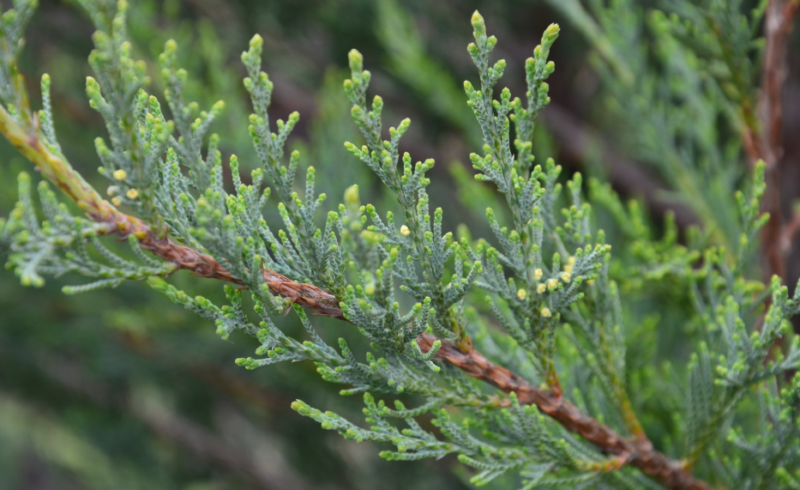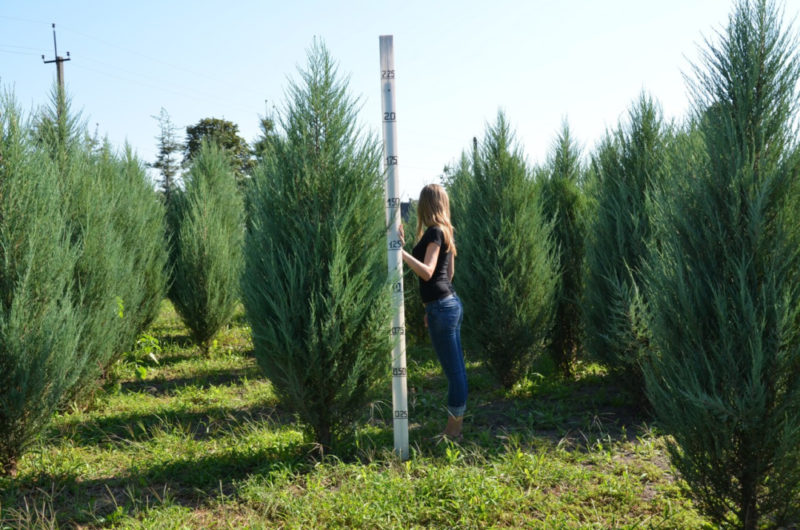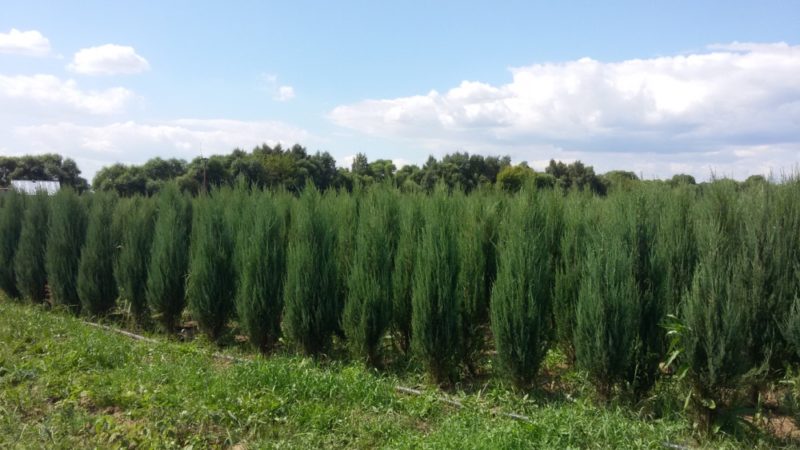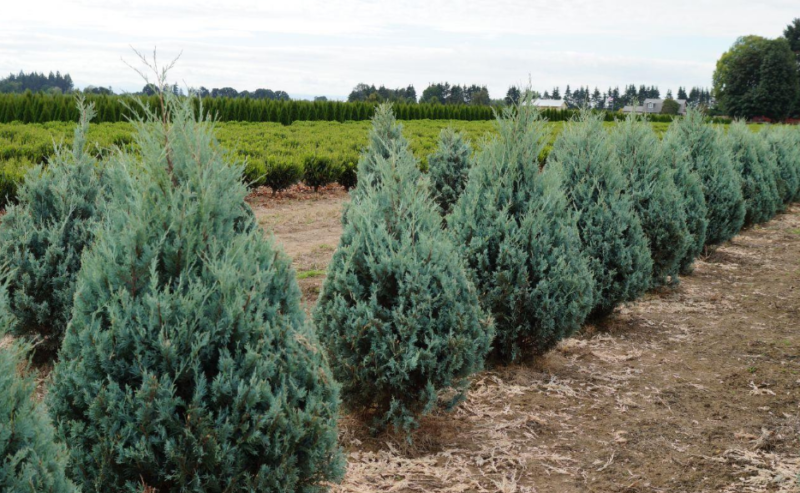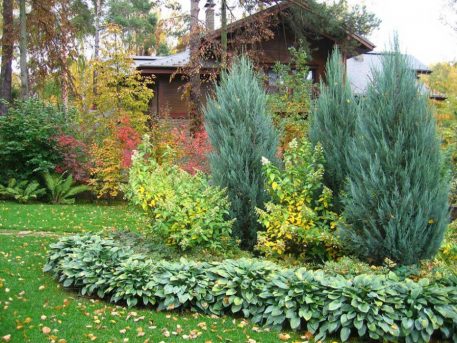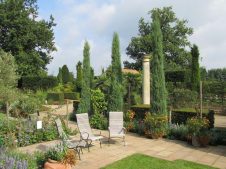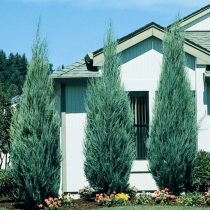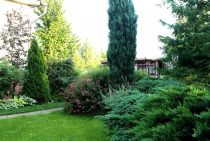A special role is given to designers by juniper rocky in landscape design. Extraordinary decorativeness, endurance, variety of forms, incredible compatibility with other plants allow you to use it in various compositions. Knowing the nuances of growing, any gardener will be able to decorate his site with its many varieties.
Material Content:
Description of varieties of juniper rocky
As an ornamental plant, the evergreen conifer has been cultivated since 1839. Thanks to American breeders, species diversity has about 20 varieties.
They differ:
- the structure of the crown - dense or prostrate;
- crown shape - pyramidal, columnar, oval, columnar;
- the color of the needles is dark green, deep blue, bluish-green, gray-gray, greenish-blue;
- the structure of the needles is scaly or needle-shaped;
- height - average - 2 m, maximum - 6 m.
Rock juniper grows in the form of a tree or bush, slowly, the average annual growth is 5 - 15 cm, but differs in a long growth period (some specimens live up to 1000 years).
Crohn begins almost at the root, which enhances its decorativeness. Numerous thin branches are covered with tightly pressed scaly or needle needles, only 1 - 2 mm long, adding lightness and grace to the plant.
All varieties of rock junipers are hardy, therefore they are successfully grown in Russian regions.
Here are some popular varieties:
- Juniper rocky "Munglow" (Moonglow). A plant with a broadly pyramidal crown, in culture grows up to 5 m in height.It grows relatively quickly, annual growth is up to 20 cm. It is distinguished by the vertical growth of branches, slightly deviating on the sides, and the delicate silver-blue color of soft needles, more saturated in winter. It is quite resistant to drought, wind and frost, but the fragility of the branches does not withstand the sticking of a large amount of snow.
- Juniper rocky "Blue Haven" (Blue Heaven). A tall narrow columnar tree with raised dense branches. Height 3 - 5 m, width - 1.5. It grows up to 20 cm per year. A feature is the constant sky-blue color of the needles, not dimming in the winter. This color is recognized by experts as the best among blue junipers. Prefers the sun, in the shade of the crown grows more friable, rare. Despite the high growth and narrow crown, it is resistant to strong winds. Not afraid of frost and drought. It is not pretentious to soils, even resists salinity. Endures city conditions.
- Juniper rocky "Skyrocket" (Juniperus scopulorum Skyrocket). "Sky rocket" (translated from English) lives up to its name. A tall tree with a narrow columnar crown of 6 - 8 m. The branches growing strictly vertically and the outgoing rigid shoots are tightly pressed to the trunk, creating a perfectly even column. The needles are scaly. It grows rapidly, adding 20 cm in length and 5 cm in width per year. The color of the hard scales is bright, bluish-green. Sun loving. Does not accept fertile soil. It prefers drained loamy soil, tolerates minor salinization. Despite the developed root system, it is not resistant to strong winds. The best landing site is sunny and non-blown.
- Juniper rocky "Blue Arrow" (Blue Arrow). The most popular among all varieties of rock junipers. It has similarities with Skyrocket, only more compact. By the age of ten, it grows up to 3 m with a width of an even crown of no more than 70 cm. Elastic strong branches grow strictly vertically, clinging to the trunk, due to this, snow sticks are not afraid of it - it remains decorative without pulling down the shoots. Unlike Skyrocket, the needles are soft, deep blue, sometimes needle-shaped and scaly. The culture is not moody. Resistant to weather vicissitudes, but prefers sunny lee places.
You can decorate the territory with other decorative varieties:
- with open crown: Siver King, Winter Blue, Monam;
- oval: Table Top Blue;
- Conical: Dew Drop, Gray Gleam;
- columnar: Greenspire, Springbank;
- with drooping branches and green needles: Tolleson, s Green Weeping.
Whatever varieties are grown on the site, in addition to the aesthetic function, they also heal the air, exuding a large number of volatile products.
Outdoor landing
The agricultural technology of planting rocky juniper is not complicated. Since seedlings are sold mainly with a protected root system, they can be planted at any time during the growing season. It is important to choose the right location, which depends on the variety of conifers.
Landing area should be:
- sunny - in the shade of the plants thinning and lose their decorativeness;
- leeward - due to the fragility of young shoots;
- with a deep occurrence of groundwater.
Given the natural growth of rocky juniper in mountainous areas, it is desirable that the soil is breathable, loamy, because too nutritious soil can change the appearance of conifers, especially undersized varieties - they will stretch.
Some varieties feel better in growth-free conditions. Another important acidity of the soil. In general, when choosing a place and soil, it is necessary to take into account the individual characteristics of the variety.
- Before planting, the container with the bush is watered abundantly so that the roots are not damaged during excavation.
- The landing hole is dug 2 times more than the earthen lump of the conifer.
- A mixture is prepared from equal parts of garden soil, peat and sand.
- The bottom is covered with drainage.
- The tree is set so that the root neck is strictly at ground level.
- It is filled up with a substrate, rammed. It is watered.
- If the soil is donkey, you must add soil and water again.
- The trunk circle is mulched by bark or wood chips.
Shrub care
Young, just planted, trees need regular watering, shading from direct sunlight. Adult plants can not be watered - they tolerate even prolonged drought, but will be grateful for the warm sprinkling on the crown in the hot period, which can be carried out in the evening.
You need to feed conifers in the spring, but with great care and not use organic matter, but only special fertilizers for conifers.
Cutting scheme and technology
Rock junipers tolerate crown shearing in spring and autumn. Although they are very decorative and without pruning, it is necessary to remove wild shoots, broken, dried and too thick branches to prevent the development of diseases. Also, giving the trees different shapes, you can add informality and fantasticness to the garden. True, a topiary haircut requires patience, time, a clear vision and accuracy.
And yet, there are some juniper pruning rules for the painless process:
- Do not shear at temperatures below +4 ° C - the sections do not heal, and in June and July - there is an active sap flow and plant growth;
- it is possible to trim 5-year-old specimens and if 2 years have passed after disembarkation;
- to form a plant no more than 2 times a year;
- all slices are made at an angle;
- for crown density and growth inhibition, a third of the top growth is cut off in autumn;
- prevent bifurcation of the tree - form in one trunk to prevent rupture;
- remove from the shoot no more than 1/3 and only a couple of mm above the kidney;
- when holding a topiary haircut, adhere to the natural form.
It should be remembered that many species emit toxic juice, so it is necessary to use personal protective equipment. Pruning tools should be sharp and sterile, since the broken section heals for a long time and contributes to the infection of the plant with diseases. It is recommended to process the tree with fungicide after cutting.
How to care in winter
Winter care is expected in areas with a lot of snow falling. It is necessary to shake off the snow from the branches or pull them with twine to the trunk, otherwise the shape of the crown is lost - shaggy, break off shoots. Young and low specimens can be wrapped with agrofibre - it will also protect against frostbite of shoots in large frosts.
Juniper propagation
The peculiarity of the plant is dioeciousness, that is, both male and female trees are needed to obtain seeds in their area. And the seeds do not ripen every year, so the seed method for propagating varieties of rock juniper is practically not used.
A cheaper and more affordable method of renewal is cuttings. It can be carried out both in the spring (April), and in the fall (September - October). The seedlings obtained by cuttings are more viable, better take root and develop in the open ground, are almost not exposed to pests.
Tall junipers are propagated by cuttings taken from the tops of vertically growing stems, but not the strongest, no more than 12-15 cm.
With open crown - any, except vertical, because the seedling from a vertical shoot will stretch up. The handle should be with a piece of old bark or with a “heel”.
The root for rooting can be from pure coarse sand and perlite (2: 1), or from sand and acid peat (3: 1).
Rooted cuttings at an angle of 70 ° with the outer side up, at t +15 - 18 ° C, with a gradual increase to +22 ° C, but above tо it is not recommended. Planting is watered and a “greenhouse” is created. After 1 - 1.5 months, roots will appear. In winter, boxes with seedlings are dug in the garden, in the spring they are planted in a permanent place.
Juniper with open crown can be propagated by horizontal layering, pressing and digging the branch extending to the side to the ground.
Protection against diseases and pests
Ephedra are rarely affected by diseases, but can catch a harmful parasite from neighboring plants, as well as when using affected planting material, adverse weather conditions or breaches of care:
- fungal diseases: brown shute, rust, necrotic cancer;
- root rot (from increased humidity of air and soil);
- yellowing and decay of needles (soil depletion).
Junipers can be protected by preventive spraying in early spring and late autumn with copper-containing preparations or other fungicides and insecticides.
It is important to monitor the composition of the soil, timely feed with special fertilizers. Timely carry out sanitary pruning in order to ensure good ventilation of the crown, to remove fallen needles and other dry residues from the territory.
You should not plant an apple, quince, pear, dogwood, hawthorn next to the conifer, because they are intermediate hosts of common pathogens and can transmit the disease to juniper.
Of the pests, young seedlings can be threatened by:
- aphid;
- juniper scale;
- gall midge;
- spruce spider mite;
- caterpillars of sawfly and shoot moth;
- butterflies of a pine moth.
At the first signs of the appearance of insects, it is necessary to collect individuals, with large accumulations, cut and burn branches, dig up tree trunks, and spray with insecticides. Prevention will help prevent the problem.
Landscaping Ideas
For a stylish exterior of a personal plot, and indeed of any territory, junipers are irreplaceable plants. It is impossible to find another culture, the combination of which would be so harmonious.
Rocky juniper is magnificent as a tapeworm, and you can’t imagine a better background on a flower bed with any flowers and herbs. Alley, hedge, group planting of conifers, with deciduous trees and shrubs, in the Scandinavian-style gardens, Japanese, English, in rock gardens - everywhere the rocky juniper looks organic.
And unique topiary or simply masterfully executed single figure - it's just fantastic!
And yet, no matter how skillfully created the landscape, he needs care. A caring attitude to the wards is the gardener's task, and the plants will respond with a dazzling, lush crown.


